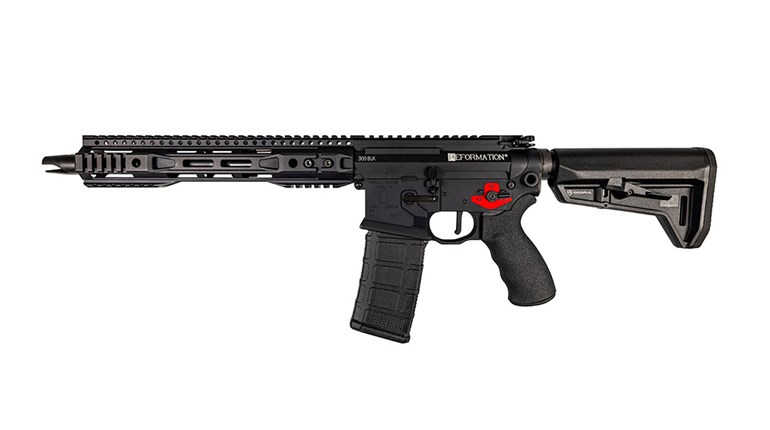
Although we are a fickle bunch when configurations seem to be limited only by our imaginations, certain trends in components and accessories have emerged—at least for now. Today's AR is not the same rifle it was just a few years ago, as Del-Ton demonstrates with its new DTI Evolution.
The Evolution gets its name in part from its handguard. Del-Ton ditches yesteryear's must-have quad-rail fore-end and replaces it with a lithe aluminum tube, also called the Evolution, from Samson. Once the novelty of hanging everything but the kitchen sink on an AR wore off, shooters realized a handguard with four, full-length rails was cumbersome—even when it was unencumbered with gadgets. The Samson unit measures a slim 1.80 inches wide for a comfortable fit in the hand, but it permits even more mounting options for lights and lasers than a quad-rail fore-end.
Sets of 10 holes running along the handguard's flats at the 3-, 6- and 9-o'clock positions accept bolts for attaching rail sections. In addition, S-shaped cutouts in the tube allow you to mount rail sections at a 45-degree offset from each of these positions. In this setup, the fore-end wall is sandwiched between a rail and a backer, with the bolts securing the three pieces together. The design offers a good deal of flexibility, but there is a drawback. In order to attach a rail section and a backer to the fore-end other than at its very front, you must remove it from the upper, at least if you want to preserve your sanity.
Fortunately, detaching the free-float tube isn't a big deal. The fore-end mates to the barrel nut via a two-piece, grooved bushing. Loosening the two bolts on the handguard's underside relieves pressure on the bushing. A trough inside the fore-end provides plenty of clearance for the low-profile Samson gas block, and you can slide the tube off the front of the upper without any interference.

The stainless steel bushing does double-duty by also serving as a heat dissipater. It surrounds the barrel nut—and therefore the chamber area of the barrel—and provides additional surface area to aid in cooling. In this way, the bushing helps to slow the transfer of heat to the hand guard.
Under the fore-end, the rifle has a 16-inch, chrome-lined, chrome-moly barrel with a mid-length gas system. Here is another feature that has recently increased in popularity with shooters. Not that long ago, most 16-inch guns came from the factory with carbine-length gas systems. The mid-length arrangement allows slightly less gas to enter the gas key due to reduced dwell time of the bullet in the bore. Many students of the AR consider this pairing to offer just enough gas to reliably cycle the bolt-carrier group without causing undue stress to the assembly. The Evolution also employs an H, or heavy, buffer to slow down cycling for less wear on the bolt-carrier group.
The buffer resides in a mil-spec buffer tube, attached to which is a Magpul CTR buttstock. The CTR looks deceivingly minimalist. An ambidextrous socket for a quick-detach sling mount and a friction lock to help prevent the stock from wobbling around the buffer tube are two features that belie its simple lines. Another Magpul upgrade Del-Ton includes on the Evolution the MOE+ grip. It's made of polymer like the standard MOE grip, but also has a rubber-overmold outer surface for better purchase. The slightly tacky rubber almost feels soft in the hand and certainly helps prevent the palm from slipping down the grip.
The Evolution comes with a set of Samson folding sights. They are brawny and rugged, but the rear unit caused some frustration when I tried to mount a riflescope to the Evolution's railed upper receiver.

The flip-up design requires a bit of clearance between the receiver and the frame that holds the dual aperture, and therefore it cannot lie flat against the upper when folded. This small gap, coupled with the width of the aperture frame, made the rear sight too high to attach the Leupold VX-6 Multigun scope I wanted to use for testing with most mounts I tried. After three mounts failed to allow the scope's ocular bell to clear the rear sight, I finally arrived at the Wilson Combat Accu-Rizer, which did the trick.
The Evolution rewarded my efforts with pleasing accuracy. The rifle consistently turned in 100-yard groups in the 1.25-inch range with two of the loads I used during testing, and there were no malfunctions. The two-stage trigger had some creep, but a reasonable pull weight of less than 4.5 pounds helped me make nice clusters of bullet holes in the targets. Trends may come and go, but the performance offered by the Del-Ton DTI Evolution will always be in style.
Specifications
Manufacturer: Del-Ton; (910) 645-2172
Action Type: Direct-gas-impingement, semi-automatic
Caliber: 5.56 NATO
Capacity: 30 rounds
Upper and Lower Receiver: Hard-coat-anodized, forged 7075 T6 aluminum
Barrel: Chrome-lined, chrome-moly; 16 inches
Rifling: 6 grooves; 1:9-inch, RH twist
Sights: Samson folding dual-aperture rear and HK-style front
Trigger Pull Weight: 4 pounds, 6 ounces
Stock: Magpul CTR
Length: 32.38 to 35.63 inches
Weight: 6 pounds, 13 ounces
Accessories: Three rail sections, lock, empty-chamber flag, manual
MSRP: $1,300
Shooting Results
| Load | Velocity | Group size | ||
| Smallest | Largest | Average | ||
| Hornady Varmint Express 55-grain V-Max | 2,904 | .94 | 1.30 | 1.19 |
| PMC Bronze 55-grain FMJ-BT | 2,933 | 1.24 | 1.67 | 1.52 |
| Federal Premium Gold Medal Match 69-grain Sierra MatchKing BTHP | 2,641 | .79 | 1.22 | 1.15 |
Velocity measured in fps 10 feet from the muzzle for 10 consecutive shots with an RCBS AmmoMaster chronograph. Temperature: 86 degrees Fahrenheit. Accuracy measured in inches for five consecutive, five-shot groups at 100 yards from a sandbag rest.




































